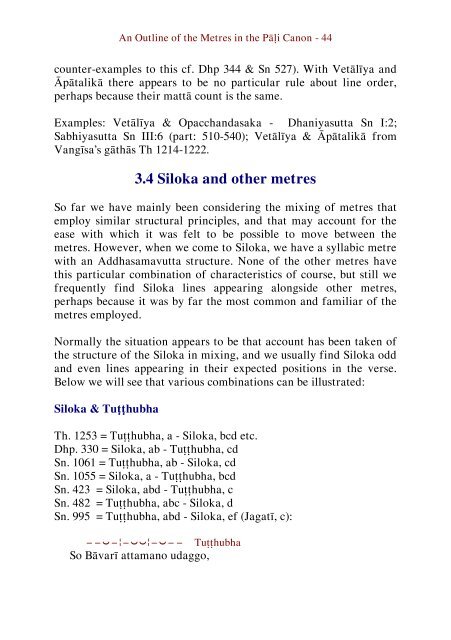An Outline of the Metres in the Pāḷi Canon
A concise but thorough explanation of the metres that are found in the Pāli canon, along with examples and glossary.
A concise but thorough explanation of the metres that are found in the Pāli canon, along with examples and glossary.
Create successful ePaper yourself
Turn your PDF publications into a flip-book with our unique Google optimized e-Paper software.
<strong>An</strong> <strong>Outl<strong>in</strong>e</strong> <strong>of</strong> <strong>the</strong> <strong>Metres</strong> <strong>in</strong> <strong>the</strong> <strong>Pāḷi</strong> <strong>Canon</strong> - 44<br />
counter-examples to this cf. Dhp 344 & Sn 527). With Vetālīya and<br />
Āpātalikā <strong>the</strong>re appears to be no particular rule about l<strong>in</strong>e order,<br />
perhaps because <strong>the</strong>ir mattā count is <strong>the</strong> same.<br />
Examples: Vetālīya & Opacchandasaka - Dhaniyasutta Sn I:2;<br />
Sabhiyasutta Sn III:6 (part: 510-540); Vetālīya & Āpātalikā from<br />
Vangīsa’s gāthās Th 1214-1222.<br />
3.4 Siloka and o<strong>the</strong>r metres<br />
So far we have ma<strong>in</strong>ly been consider<strong>in</strong>g <strong>the</strong> mix<strong>in</strong>g <strong>of</strong> metres that<br />
employ similar structural pr<strong>in</strong>ciples, and that may account for <strong>the</strong><br />
ease with which it was felt to be possible to move between <strong>the</strong><br />
metres. However, when we come to Siloka, we have a syllabic metre<br />
with an Addhasamavutta structure. None <strong>of</strong> <strong>the</strong> o<strong>the</strong>r metres have<br />
this particular comb<strong>in</strong>ation <strong>of</strong> characteristics <strong>of</strong> course, but still we<br />
frequently f<strong>in</strong>d Siloka l<strong>in</strong>es appear<strong>in</strong>g alongside o<strong>the</strong>r metres,<br />
perhaps because it was by far <strong>the</strong> most common and familiar <strong>of</strong> <strong>the</strong><br />
metres employed.<br />
Normally <strong>the</strong> situation appears to be that account has been taken <strong>of</strong><br />
<strong>the</strong> structure <strong>of</strong> <strong>the</strong> Siloka <strong>in</strong> mix<strong>in</strong>g, and we usually f<strong>in</strong>d Siloka odd<br />
and even l<strong>in</strong>es appear<strong>in</strong>g <strong>in</strong> <strong>the</strong>ir expected positions <strong>in</strong> <strong>the</strong> verse.<br />
Below we will see that various comb<strong>in</strong>ations can be illustrated:<br />
Siloka & Tuṭṭhubha<br />
Th. 1253 = Tuṭṭhubha, a - Siloka, bcd etc.<br />
Dhp. 330 = Siloka, ab - Tuṭṭhubha, cd<br />
Sn. 1061 = Tuṭṭhubha, ab - Siloka, cd<br />
Sn. 1055 = Siloka, a - Tuṭṭhubha, bcd<br />
Sn. 423 = Siloka, abd - Tuṭṭhubha, c<br />
Sn. 482 = Tuṭṭhubha, abc - Siloka, d<br />
Sn. 995 = Tuṭṭhubha, abd - Siloka, ef (Jagatī, c):<br />
−−⏑−¦−⏑⏑¦−⏑−− Tuṭṭhubha<br />
So Bāvarī attamano udaggo,

















